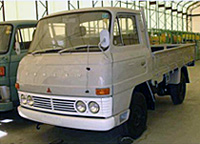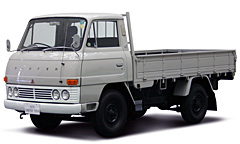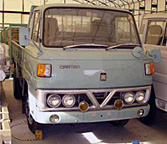Mitsubishi Fuso Unveils Restored, Historical TrucksAugust 27, 2010 |
| • | Three Canter Trucks from the 1970s Restored to Original Condition by Fuso Volunteers |
| • | Part of Larger “Fuso Historical Vehicle Restoration Project” |
| • | “Showing Mitsubishi Fuso’s Legacy of Technology Innovation” |
Kawasaki – Mitsubishi Fuso Truck and Bus Corporation (MFTBC), one of Asia’s leading commercial vehicle manufacturers, is unveiling three, fully restored historical trucks. Meticulously refurbished to their original conditions and drivable, the 2nd-generation Canter T91A (1970 model), 2nd-generation Canter T95AD (1970 model) and 3rd-generation Canter T210C (1975 model) will appear at various media, customer, employee and public events in the coming months and years. “These restored vehicles show Mitsubishi Fuso’s legacy of technological innovation which continues today with our focus on highly efficient, environmentally-friendly trucks and buses,” said Prof. Dr. Eike Boehm, MFTBC Vice President of Product Engineering. “These trucks surely provided a long service life to their customers, and now they will live on as strong examples of Mitsubishi Fuso’s product heritage.” According to Prof. Dr. Boehm, the three vehicles are the first achievements of a larger “Fuso Historical Vehicle Restoration Project,” which started in April 2008. The aim is to restore 15 Mitsubishi Fuso historical vehicles in total including four heavy-duty trucks, five medium-duty trucks, five light-duty trucks, and one light-duty bus. The purposes of this project are to convey Mitsubishi Fuso’s history, to enhance pride about the company’s products and to learn restoration skills. The restoration project team, led by Prof. Dr. Boehm, consists of about 30 volunteers mainly from MFTBC’s R&D and Testing departments. The volunteers gather on weekends and holidays to work on restoring the vehicles at MFTBC’s Kitsuregawa Proving Ground in Tochigi Prefecture, Japan, and at the company’s Kawasaki, Japan, Plant. With the goal of making the historical vehicles drivable, the project team implemented comprehensive maintenance and repairs. The vehicles were disassembled down to parts level with missing or unable-to-fix parts fabricated. One challenge in the restoration was to address corrosion due to extended time out of use and sitting outdoors. Finally, after many volunteer hours, the first three restored vehicles have been prepared. Prof. Dr. Boehm said the project also provides a “back-to-basics” learning experience for the volunteer members. “With the restoration activity, we once again reflect on the basic structure of a vehicle,” he explained. “At the same time, it gives us good opportunity to recognize the significance of manufacturing by breaking down vehicles and reassembling them. We can apply the learning of this restoration actively in our development of current trucks with advanced information technologies, as we aim to create vehicles based on strong fundamentals.” |
| Details of Restored, Historical Vehicles |
| 1. T91A Canter light-duty truck, 1970 model. |
| • | Second generation Canter. |
| • | Launched in July 1968 as T90 series. |
| • | Produced 1968-1975. |
| • | First full model change after the original launch of the Canter in 1963. |
| • | Realized the highest level of acceleration and cargo space in its class at the time. |
| • | Offered diesel engine of 75 PS and gasoline engine 90 and 95 PS. |
 T91A before restoration |
 T91A after restoration |
| 2. T95AD Canter light-duty truck, 1970 model |
| • | Second generation Canter. |
| • | Produced 1968-1975. |
| • | One of T90 series, with a cargo bed built for a dump body. |
| • | Following the T90 series launch, Fuso’s market share in this segment doubled. |
| • | The total production of Canter recorded 100,000 units in May 1, 1972. |
 T95AD before restoration |
 T95AD after restoration |
| 3. T210C Canter light-duty truck |
| • | Third generation Canter. |
| • | Produced 1973-1978. |
| • | T200 series were launched in 1973. |
| • | Major changes including the front panel of the cab. |
| • | While the previous gasoline engine improved 5 PS, MCA system for emission gas control was adopted. |
| • | Three-ton diesel engine model was added to the Canter line which had earned a good reputation with its abundant model variations. |
| • | Truck specifications varied such as low-floor/high-floor types and standard/long wheelbase, depending on cargo size and contents to be loaded. This choice of specifications was notable for the time. |
 T210C before restoration |
 T210C after restoration |
| About MFTBC
Based in Kawasaki, Japan, Mitsubishi Fuso Truck and Bus Corporation (MFTBC) is one of Asia's leading commercial vehicle manufacturers. In 2009, the company sold a total of about 99,500 vehicles including light-, medium- and heavy-duty trucks and buses. Daimler AG owns 85% of MFTBC shares and various Mitsubishi group companies own 15% of MFTBC shares. MFTBC is an integral part of the Daimler Trucks Division of Daimler AG. Mitsubishi Fuso is “All for you.” |
![]()
![]()
